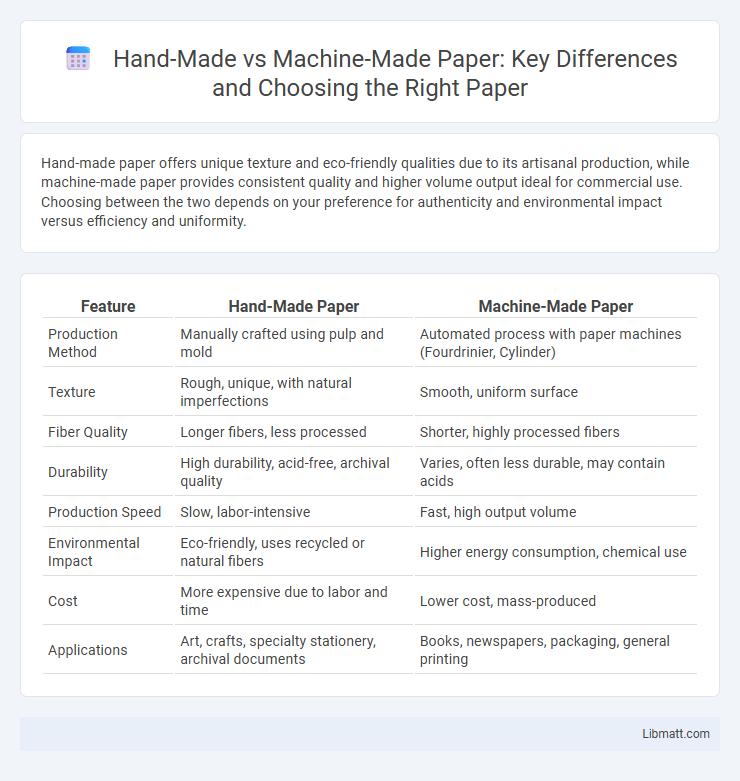Hand-made paper offers unique texture and eco-friendly qualities due to its artisanal production, while machine-made paper provides consistent quality and higher volume output ideal for commercial use. Choosing between the two depends on your preference for authenticity and environmental impact versus efficiency and uniformity.
Table of Comparison
| Feature | Hand-Made Paper | Machine-Made Paper |
|---|---|---|
| Production Method | Manually crafted using pulp and mold | Automated process with paper machines (Fourdrinier, Cylinder) |
| Texture | Rough, unique, with natural imperfections | Smooth, uniform surface |
| Fiber Quality | Longer fibers, less processed | Shorter, highly processed fibers |
| Durability | High durability, acid-free, archival quality | Varies, often less durable, may contain acids |
| Production Speed | Slow, labor-intensive | Fast, high output volume |
| Environmental Impact | Eco-friendly, uses recycled or natural fibers | Higher energy consumption, chemical use |
| Cost | More expensive due to labor and time | Lower cost, mass-produced |
| Applications | Art, crafts, specialty stationery, archival documents | Books, newspapers, packaging, general printing |
Introduction to Hand-Made and Machine-Made Paper
Hand-made paper is crafted using traditional techniques involving manual processes like sheet forming and air-drying, resulting in unique textures and irregularities favored for artistic purposes. Machine-made paper is produced through automated processes on industrial machines, enabling high-volume, consistent quality ideal for printing and packaging. Your choice between hand-made and machine-made paper depends on the desired texture, durability, and production scale for your project.
Historical Background of Paper Production
Hand-made paper originated over 2,000 years ago in ancient China, where mulberry bark and other natural fibers were manually pulped and pressed, leading to unique textures and durability. Machine-made paper emerged during the Industrial Revolution in the early 19th century, revolutionizing production with mechanized processes like the Fourdrinier machine that vastly increased speed and volume. The historical shift from artisanal hand-crafted methods to industrial automation reflects advances in technology and the growing demand for standardized, mass-produced paper worldwide.
Key Differences in Manufacturing Processes
Hand-made paper is produced through traditional methods where pulp is manually spread on a wire mesh frame, allowing more control over texture and fiber alignment, resulting in thicker, more textured sheets with natural irregularities. Machine-made paper uses automated, high-speed Fourdrinier or cylinder mold machines that rapidly press, dry, and smooth the pulp into uniform sheets, optimizing efficiency and consistency for mass production. The key difference lies in hand-made paper's labor-intensive process ensuring unique natural characteristics versus the mechanized, continuous process of machine-made paper creating standardized, uniform products.
Material Sources and Sustainability
Hand-made paper typically uses natural fibers like cotton, hemp, or recycled materials, making it highly sustainable and eco-friendly due to minimal chemical processing. Machine-made paper often relies on wood pulp from industrial logging, which can contribute to deforestation and higher environmental impact unless sourced from certified sustainable forests. Choosing hand-made paper can enhance your commitment to sustainability by supporting traditional methods and reducing reliance on synthetic materials.
Texture and Appearance Comparison
Hand-made paper features a unique, uneven texture with visible fibers and natural imperfections, giving each sheet an organic and artisanal appearance. Machine-made paper offers a consistently smooth surface with uniform thickness, suitable for high-volume printing and commercial applications. The tactile qualities of hand-made paper emphasize craftsmanship, while machine-made paper prioritizes efficiency and uniformity in texture and appearance.
Durability and Longevity Considerations
Hand-made paper exhibits superior durability due to its longer fibers and natural production process, which enhances tear resistance and longevity compared to machine-made paper. Machine-made paper often contains shorter fibers and chemical additives that can weaken the paper over time, making it more susceptible to yellowing and brittleness. Choosing hand-made paper ensures your documents or artworks maintain their quality and last significantly longer in archival conditions.
Environmental Impact and Eco-Friendliness
Hand-made paper typically has a lower environmental impact due to its production process, which uses minimal energy and fewer chemicals compared to machine-made paper. Machine-made paper often relies on energy-intensive manufacturing and chemical treatments that contribute to higher carbon emissions and water pollution. Choosing hand-made paper supports eco-friendliness by reducing your ecological footprint and promoting sustainable materials.
Applications and Best Use Cases
Hand-made paper excels in artisanal applications such as calligraphy, bespoke invitations, and fine art printing due to its unique texture and durability. Machine-made paper suits mass production needs like office documents, packaging, and standard printing where consistency and cost-efficiency are priorities. Your choice depends on whether you prioritize aesthetic appeal and craftsmanship or volume and uniformity.
Cost and Accessibility Overview
Hand-made paper typically costs more due to the labor-intensive process and limited production scale, making it less accessible for large-scale needs. Machine-made paper is mass-produced efficiently, resulting in lower prices and widespread availability suitable for everyday use. Your choice depends on whether you prioritize artisanal quality or cost-effective volume.
Conclusion: Choosing Between Hand-Made and Machine-Made Paper
Choosing between hand-made and machine-made paper depends on your specific needs for texture, durability, and environmental impact. Hand-made paper offers unique fibers, eco-friendliness, and artisanal quality but at a higher cost and limited availability. Machine-made paper provides consistency, affordability, and mass production efficiency, making it ideal for everyday use and commercial purposes.
hand-made paper vs machine-made paper Infographic

 libmatt.com
libmatt.com